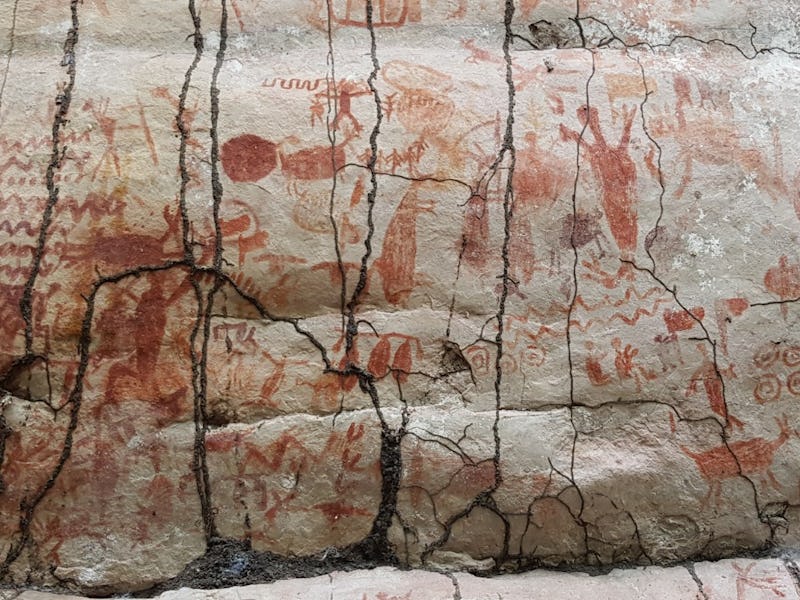Newly discovered art is an ancient Amazon time machine
Long-lost rock paintings reveal some incredible Ice Age artists.

Ancient people fascinate us, but we know so little about how they imagined the world around them.
Rock art offers us traces of these ancient peoples' creativity — their hopes, dreams, and their relationship with the natural world. Newly discovered cave paintings made by ancient people living in what is now the Amazon reveal how they interacted with the flora and fauna around them, including now-extinct Ice Age creatures like the mastodon.
An example of the ancient rock art found in the Colombian Amazon.
Ancient artists — The paintings, found as part of the LASTJOURNEY project, were first detailed in a study published earlier this year in the journal Quaternary International. The cave paintings are also featured in a new series, "Jungle Mystery: Lost Kingdoms of The Amazon," screening on Channel 4 in the United Kingdom during December.
The scorching red paintings, which are between 11,800-12,600 years old, feature a treasure trove of information about the hunter-gatherer people living in the Amazon during the Ice Age.
Mark Robinson is a post-doctoral research fellow at the University of Exeter and member of the project team. In a statement marking the television series' premier, he highlights the sheer creativity these paintings demonstrate.
"These really are incredible images, produced by the earliest people to live in western Amazonia," he says.
A human hand next to ancient depiction of handprints on the rock walls.
These studies were made possible after the Colombian government and the Revolutionary Armed Forces of Colombia signed a peace treaty, allowing researchers to enter the region. Working alongside members of local communities in the Amazon, researchers from Exeter and Colombian universities Universidad de Antiquoia and Universidad Nacional de Colombia were able to study the rock paintings in detail. They were discovered during excavations at three sites carried out between 2017 and 2018.
To create the paintings, the researchers hypothesize the ancient artists peeled back the rock using fire to create a blank canvas. The paintings offer us insights into the daily lives of our ancient ancestors, who seem to have gone to great lengths to paint in nearly inaccessible caves high above the ground. It is possible they even constructed ladders to allow for visitors, the researchers say.
As for the paintings themselves, they display an array of handprints, geometric shapes, humans, and, of course, animals.
Researchers identified bats, monkeys, turtles, and several other creatures represented in the paintings, but, perhaps most excitingly, they also found artwork featuring giant — and now-extinct — Ice Age mammals, like the famous mastodon, giant sloths, and three-toed hoofed creatures known as ungulates.
The paintings show how humans once lived alongside these fascinating megafauna.
An expansive view of the rock art in the Colombian Amazon.
"The paintings give a vivid and exciting glimpse into the lives of these communities. It is unbelievable to us today to think they lived among, and hunted, giant herbivores, some which were the size of a small car,” Robinson says in the statement.
"The pictures show how people would have lived amongst giant, now extinct, animals, which they hunted," José Iriarte, professor of archaeology at the University of Exeter and one of the researchers on this project, says in a statement accompanying the findings.
A Changing Climate — The researchers on this project originally set out into the Colombian Amazon to discover how ancient people both adapted to and affected the environment around them. Their findings confirm one of the earliest-known human occupations of the Colombian Amazon.
Beyond the paintings, the researchers also uncovered remains of what ancient people ate in the rock shelters — an omnivorous mix of alligators, palm fruits, and armadillos.
The paintings are a time capsule, revealing an Amazon in flux driven by climate change. Around the time these paintings were made, the Amazon was in the midst of a dramatic transformation from a temperate land composed of savannah and scrub to the tropical rainforest we know today.
A close up of one of the designs found showing an ancient animal.
"They moved into the region at a time of extreme climate change, which was leading to changes in vegetation and the make-up of the forest. The Amazon was still transforming into the tropical forest we recognize today," says Robinson.
We can also see from these paintings how ancient humans shaped the environment around them and sustained themselves.
"These rock paintings are spectacular evidence of how humans reconstructed the land, and how they hunted, farmed and fished," Iriarte says.
We rarely think about South America when it comes to stereotypical depictions of the Ice Age, but these paintings show we need to think beyond our modern-day environment to understand how humans survived and thrived during this time.
"It is likely art was a powerful part of culture and a way for people to connect socially," Iriarte says.
This article was originally published on